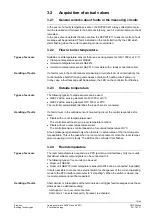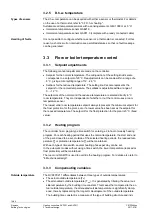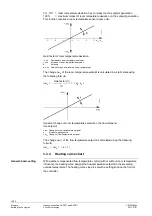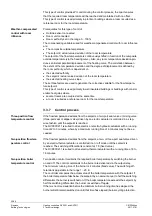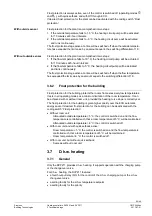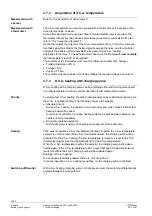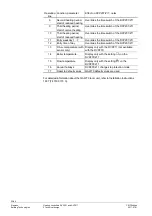
26/46
Siemens
Heating controllers RVP201 and RVP211
CE1P2464en
Building Technologies
3 Technical design
2017-07-21
3.7.2 Acquisition of d.h.w. temperature
Refer to "3.2 Acquisition of actual values".
The d.h.w. temperature can also be acquired with a thermostat, at the expense of re-
duced functionality, however.
Since all measuring circuits use low voltage, an intermediate relay is required. The
thermostat controls the relay whose contacts are connected to terminals B3-M (also
refer to "5.2 Connection diagrams").
On the thermostat, the setpoint of the d.h.w. temperature is set. If the d.h.w. tempera-
ture falls below the setpoint, the thermostat will energize the relay, and the controller
interprets the bridging of terminals B3-M as a demand for d.h.w. heating.
Alternative to the relay: if a
new
thermostat is used, or a thermostat with
new contacts,
the intermediate relay will not be required.
The contacts of the thermostat must meet the following requirements, however:
Transfer resistance <80
Voltage <10 V
Current 10 mA
The contacts must be capable of switching reliably the required voltage and current.
3.7.3 D.h.w. heating with charging pump
D.h.w. heating with a charging pump can be employed either with mixing valve opera-
tion (flow temperature control) or boiler operation (boiler temperature control).
To ensure fast d.h.w. heating, the other heating loads can be restricted during the time
the d.h.w. is heated (priority). The following choices are available:
Absolute priority:
During d.h.w. heating, the heating circuit pump is locked, which means that all other
heating loads will be dead.
In the case of underfloor or ceiling heating systems, as well as boiler operation, ab-
solute priority is mandatory
No priority (parallel operation):
Both heating circuit pump and charging pump operate at the same time
If the sensor acquires a d.h.w. temperature that lies 5 K below the d.h.w. temperature
setpoint (or if the contact of the d.h.w. thermostat closes), the charging pump will be
activated. During d.h.w. heating, the flow temperature is raised to a level that is 16 K
(fixed value) higher than the adjusted setpoint of the d.h.w. temperature.
When the d.h.w. temperature reaches the setpoint, the charging pump will be deac-
tivated again. If the d.h.w. temperature falls to a level that lies 5 K below the setpoint
(switching differential), the charging pump will be activated again.
Enabling of d.h.w. heating:
D.h.w. heating is always enabled; there are no locking times.
In manual operation, d.h.w. heating is switched on; the charging pump is enabled.
With d.h.w. heating (charging pump or changeover valve), the switching differential lies
asymmetrically below the setpoint:
Measurement with
a sensor
Measurement with
a thermostat
Priority
Heating
Switching differential


